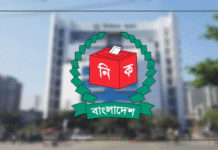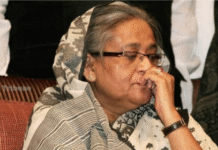An impasse between the ruling and Opposition parties in Bangladesh risks unrest, and the army might intervene. But it could dislocate the civil-military balance
“You know their character. They are quite terrorists,” Bangladesh’s Prime Minister (PM) Sheikh Hasina recently noted about the country’s main Opposition party, the Bangladesh Nationalist Party (BNP). The latter’s one-point demand for Hasina’s resignation, accompanied by serial protests despite police restrictions, violence by pro-Awami League (AL) mastans (musclemen), and counter-rallies by the ruling party has ratcheted up Dhaka’s political temperature. The BNP wants a caretaker government to administer the upcoming polls due before January 2024, but Hasina won’t budge. The balance of power — with the State apparatus under AL’s control and mass opinion rising for the BNP — is such that a stalemate has emerged. Far from being unforeseen, it has a déjà vu feel to it. But the risk with such predictably tense situations is that they can spiral out of control. Just like there is no guarantee that the BNP protests will forever remain peaceful, the endurance of Hasina’s political fortress is equally uncertain. If one is to go by the uptick in burnt buses, fake news-fueled propaganda, inter-party clashes, mass detentions, and mounting diplomatic pressure on Hasina to hold free and fair elections by the United States (US) and its European allies, the chances of political dislocation aren’t low.

The fact that no caretaker government can exist without the consent of the two parties, compels one to ask, what if a consensus is never reached? Hasina could double-down against the BNP. Even if it doesn’t lead to a mass uprising, another controversial election might trigger an armed pushback by the AL’s opponents across the ideological spectrum.
Another possibility is that the frustration over the stalemate pushes the BNP into experimenting with coercion. Hasina is desiring such an occurrence as it’ll prove her point about the BNP’s bona fides. For now, the Opposition hasn’t fallen into the trap, but that can change. Such risk of unrest offers a necessary, if not sufficient, condition for third-party intervention. The rich, recent, history of the Bangladeshi army’s involvement in politics compels a deeper exploration of this eventuality. There’s no doubt that the army can deliver on law-and-order duties in support of a caretaker setup, or even unilaterally contain violence. But the kind of intervention this will need is not predicated on consensus, wherein the army steps in as a supportive element. It occurs due to a breakdown of the existing rules of engagement, is tough to predict and undemocratic.
Under what circumstances might General SM Shafiuddin Ahmed, the chief of army staff, consider intervention? It is important to note that the dominant belief in Bangladesh is that such an occurrence is unlikely, if not unthinkable. But what Ahmed might not be thinking or planning today, may not be the case weeks from now. So, apart from an electoral logjam, what else could alter his calculus?
Let’s focus on three aspects: Institutional interests, professionalism, and India’s response. Ever since their return to the barracks in 2009 after the Bangladesh Rifles revolt, the army’s institutional interests and its senior leader’s personal interests have been tied to Hasina’s fortunes.
From bagging lucrative defence contracts and enjoying financial perks associated with United Nations (UN) peacekeeping roles, to being bereft of an external foe, the army has enjoyed being on the margins. Combine this with the success as a humanitarian first-responder and accruing prestige, and it becomes clear why the forces might prefer the barracks.
But Bangladesh’s economic distress has shaken this equilibrium. A drop in defence contracts is creating unease in the cantonment about Hasina’s ability to continue delivering. One could argue that it’s unfair to expect perennial sunshine. But such expectations are common when State-building is undergirded by elite-level corruption and familial patronage instead of constitutional integrity. Such a loss of benefits becomes potent when conditioned by the insult middle-level officers feel for not being able to stop the Rohingyas.
It is not surprising, then, that even a reduction in Bangladesh’s contribution to the peacekeeping pie since the UN’s withdrawal from Mali has begun translating into discontent. The other aspect relates to military professionalism. Shafiuddin commands respect because he is seen to be an effective, and ambitious chief. His tenure is set to expire shortly after the elections in 2024. This ties his legacy to what he does in the coming months. Herein, the sensitive balance between the chief’s office and that of Hasina’s security adviser — Major General (retired) Tarique Siddique, also the younger brother of Sheikh Rehana’s husband — becomes paramount. Unlike Shafiuddin’s professionalism, Siddique’s image has been marred by corruption charges.
If Hasina’s actions threaten to harm the army’s image in truth or myth, then the latter might justify intervention to protect institutional professionalism and, paradoxically, in the name of constitutional integrity.
But there’s one last aspect critical to it all i.e., India’s response. Something not widely known in Bangladesh is that the army was forced into the barracks under Indian pressure. In 2009, when former chief General Moeen Uddin Ahmed was being pressed by his officer corps to give shooting orders to quell the Bangladesh Rifles mutiny, India threatened military intervention if he did so. New Delhi worried about Hasina’s safety, and was unsure of Moeen’s Napoleonic ambitions. It was not a bluff.
India’s actions allowed Hasina to take charge of the situation politically and liberated her from the pressures emanating from a politicised military. Since then, she’s never looked back. Dislocation in Bangladesh’s civil-military balance due to the current political impasse could compel a relook at the 2009 playbook, pushing the subcontinent into uncharted territories.
Avinash Paliwal teaches at SOAS University of London and is the author of My Enemy’s Enemy: India in Afghanistan from the Soviet Invasion to the US Withdrawal (New York: Oxford University Press, 2017) The views expressed are personal









